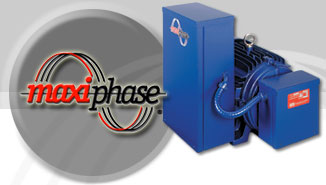| *
Selecting a converter model is similar to selecting transformer kVA
sizes. Both starting and running loads must be considered, especially
starting loads because amperages are always higher to start. Maxiphase
converters offer only one duty rating per model. There are not heavy
or super-heavy duty ratings, even though heavy and super-heavy duty
needs are found in load applications. Whenever those conditions are
present, simply choose one size larger converter for heavy duty needs
or double sizes for super-heavy duty (such as, punch presses, direct
drive centrifugal blowers, etc.)
* Total combined
horsepower ratings on all converters are general ratings. Many applications
will have motors operating in varied stages of load conditions (such
as metal or woodworking machinery, etc.) from no load to full load.
This nameplate rating which is three times the largest horsepower
rating of the converter gives a general performance rating.
* In applications which have multiple motors operating continuously
at full load use a .66 multiplier to calculate total combined horsepower
capacity. For example, an RPC 5-15 has a combined horsepower rating
of 15hp. When motors are running continuously in a full load condition,
(such as refrigeration compressors, pumps, etc.) multiply 15hp x
.66, which results in a combined total horsepower capacity of 9.90
or 10hp for the RPC 5-15 converter.
* Air conditioning
and refrigeration units are commonly underrated in horsepower. For
example, a refrigeration compressor motor rated at 7.5hp may have
a full load amp rating of 33 amps at 230 volts. An amp load of 33
amps at 230 volts is the equivalent of a 12-13 horsepower motor.
In that case an RPC 15-45 converter should be used. Always check
amp draw and load conditions before making a selection! It is also
recommended after true HP is determined to use the next larger HP
converter due to high starting current.
* Due to higher
starting currents, 3450 RPM motor applications may require the next
larger rating converter. For example, a 7.5hp 3450 RPM motor on
a wood molder which has heavy cutter heads, may require an RPC 10-30
converter. A safe rule is that 3450 RPM motors require the next
larger model converter.
* If two or
more motors start simultaneously, the combined total horsepower
of those motors would be considered the largest motor horsepower
on the converter specification chart. For example, one 1hp and one
2hp motor starting simultaneously would equal one 3hp motor. In
this case an RPC 3-9 would be the correct converter to use. NOTE:
This applies only when motors start at the same time!
* A Rotary Phase
Converter must be started before the load is applied. Starting a
converter with the load applied can cause winding failure in the
rotary converter.
* For resistive
loads (such as heating elements) determine the input amperage and
compare it to an equivalent motor horsepower amp draw. For example,
a resistive load of 18 amps would be between the amp draw of a 5hp
and a 7.5hp motor. Since it is greater than a 5hp and less than
a 7.5hp, an RPC 7.5-20 would be the correct converter. A resistive
load of 22 amps would be the maximum load for an RPC 7.5-20 converter.
No other load could be applied at the same time.
* Transformer
loads (such as battery chargers, welders, etc.) are calculated by
converting the primary amperage of the welder or charger to an equivalent
motor horsepower amperage. For example, a charger with a primary
amperage of 26 amps would be similar to a 10hp motor which has an
amperage of 28. However, you may multiply the charger amperage by
.60 which in this case gives a result of 15.6 amps. This is the
equivalent of a 5hp 230 volt 3 phase motor. The correct converter
would be an RPC 5-15.
* For operation
of 460 volt machinery from a 230 volt 1 phase source, use a step-up
transformer between the 230 volt phase converter and the 460 volt
application. An alternative is to use a step-up transformer before
the converter and choose a 460 volt phase converter.
* For extremely
hard starting or inertial load applications (such as metal shears,
punch presses, some compactors, etc.) choose a converter model which
is double the largest motor horsepower rating. For example, a metal
cutting shears with a large flywheel and a 5hp drive motor, would
require an RPC 10-30 converters.
* For CNC and
other computerized applications use CNC model converters.
|

